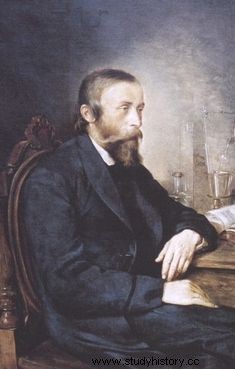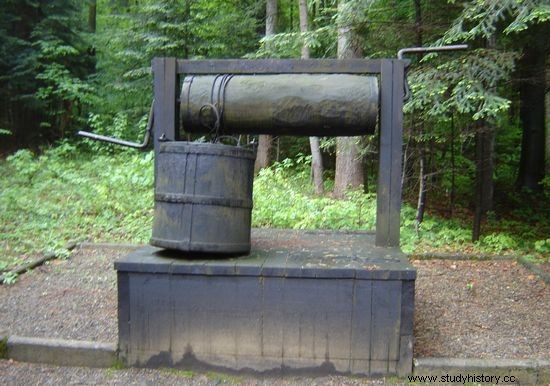Everywhere where oil was discovered at the turn of the 20th century, life changed dramatically. It was no different in the Galician Bóbrka. No wonder Szczęsny Morawski wrote:A life unknown here has awakened, a world of God that has never been before, a world of mining work has been created. You would think you were in America.
Spills of oil have happened in and around Bóbrka for a very long time - the locals called oil tar or rock oil. A use for it was found very quickly:the lubrication of cart wheels. In addition, it was also used as a remedy for fluke in sheep. Back then, no one imagined how much it would change the lives of the inhabitants of poor Galicia.
Oil rush
Fortunately, Ignacy Łukasiewicz was able to predict what could be obtained thanks to oil:fruit. 
It is therefore not surprising that the times of the oil rush followed shortly thereafter. This is how "Sztandar Polski" described it:
These were the times of a real epidemic and were based on the same conditions as playing the number lottery game. For example, somewhere in the submontane oil belt, traces that have been known for a long time have appeared.
It was enough to dip your stick along the banks of the stream to make the surface of the water stained with the rainbow colors of oil fat, then you moved your shovel over the field where nothing wanted to be born, and soon it filled up the dimple with bituminous slime.

Ignacy Łukasiewicz, the father of the oil industry himself.
Unfortunately, the joy in many cases was exaggerated. Not infrequently, after filling a few barrels with oil, the source ran out. Anyway they tried to extract the oil in every way - initially they just dug shallow pits and ditches in which water could accumulate and oil would collect on its surface . Only later did the technology develop so much that it was decided to dig deep wells.
Work? Bucket and ride 200 meters down
Regardless of the methods, the work was very dangerous. Oilers were exposed to being buried, flooded with water or suffocated by an unexpected inflow of oil or gas. Such an employee descended into a well measuring 120 cm by 120 cm. Each of them had a winch with a hemp rope to which a wooden or tin bucket was attached.

Model of one of the first excavations used in Bóbrka (photo by Szczepan Zajdel).
Two people were required to operate such a stand. The drill-digger descended to the bottom, and the other was driving the grinder with his own hands, which served as a fan supplying air to the bottom of the well.
How deep were these panes? According to Professor Fabiański's words, they even reached 200 meters. And if we add to that the lack of a lifeline, it gets really dangerous. Anyway, in 1872 a case of a fatal accident was described:
The explosion thus arose that a worker below who was at the bottom accidentally struck a fire by hitting a hard stone with an iron bar, the spark ignited the gases, which at lightning speed rushed up , taking with him the unfortunate victim by the fan standing.

Kopanka Franek, oil is at the bottom to this day (photo:Szczepan Zajdel).
Usually the work took 12 hours. Many fatal incidents were recorded during its execution. Professor Julian Fabiański described it in the article "Development of Polish oil and gas drilling":
I have vivid memories of the sympathetic type of tireless digger who risked his life every day by sliding down into the shaft in a bucket, usually uninsured with a lifeline, with a "whirlwind" in his hand, often suspect value as a safety lamp.
However, the Galician oil workers have always been faithful to the land they cultivated. Work in the mine was treated only as an additional occupation, which was a source of financing for the farm. Hence, there were escapes to perform urgent agricultural work, such as ... milking a cow.
New mod
Despite this, the oil producers stood out in the countryside (it is not just about the wealth of the wallet). Light shirts have become very fashionable, as well as dark hats or baseball caps. The richer ones very often had pocket watches, which were imported as wages from working abroad. They were usually made of tombac or silver, but there were also real golden gems. The watches came from the most respected Swiss manufacturers. No wonder it was said in the area that Puffers get pinkies like water to little poohs .

The oiler at work.
Not only workers, but also peasants grew richer if oil spurted on their territory. These lucky ones have been called "bangmen" for a sudden eruption of pus. Due to the fact that the oil industry needed a lot of hands to work, the standards were heavily lowered:
On Saturdays, payday, all work stopped […]. Sunday fun in the inn with vodka, the worker slept off on Monday, on Tuesday he remembered his job and started it on Wednesday.
Hasty exploitation of oil fields, without adequate protection for the health and lives of miners, often resulted in fatal accidents. The worker, sick or unable to work as a result of his disability, fell into extreme poverty.
Nobody was interested in the fate of the ever-growing number of oil workers . (B. Olejarz, "Mud or gold - the influence of the oil industry on rural life in the Krosno region in the second half of the 19th century")
Great professionals
In Bóbrka, the employees were perfectly trained to their profession. As a result, they were in demand on the labor market at that time. Virtually every place where there was oil could find workers from Galicia. They went to Russia, Chile, New Zealand, Borneo, Trinidad and the Dutch India. Poles most often complained about the food there: Eating rice with a huge amount of fruit every day could not replace sour rye soup, lard, potatoes.

Bóbrka. This is where the oil producers valued all over the world came from.
Crude oil made a big difference in the lives of the inhabitants - one mining inspector wrote:
Good roads, trees planted everywhere, water ditches, well-cultivated and torn meadows with water ditches, further clean and extensive buildings and plants, especially in Zręcin and Chorkówka, for this well-fed and clean peasants, […] because everywhere you can see a certain prosperity, which also caught my eyes when visiting the mine; I saw that the workers during the lunch hour cooked meat and baked pork fat, which I have not seen anywhere in Galicia. .
Unfortunately, the mine in Bóbrka began to decline quite quickly due to the decreasing amount of raw material. Importantly, minor mining continues to this day, and in the Museum of the Oil and Gas Industry in Bóbrka you can still see the oldest mining excavations and feel the atmosphere of those times, the atmosphere of the pioneers of the global oil industry.
